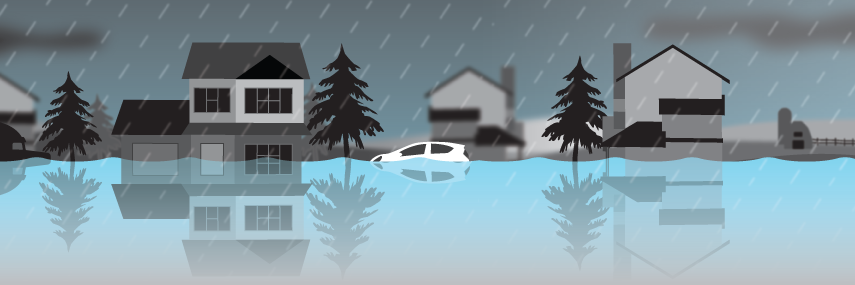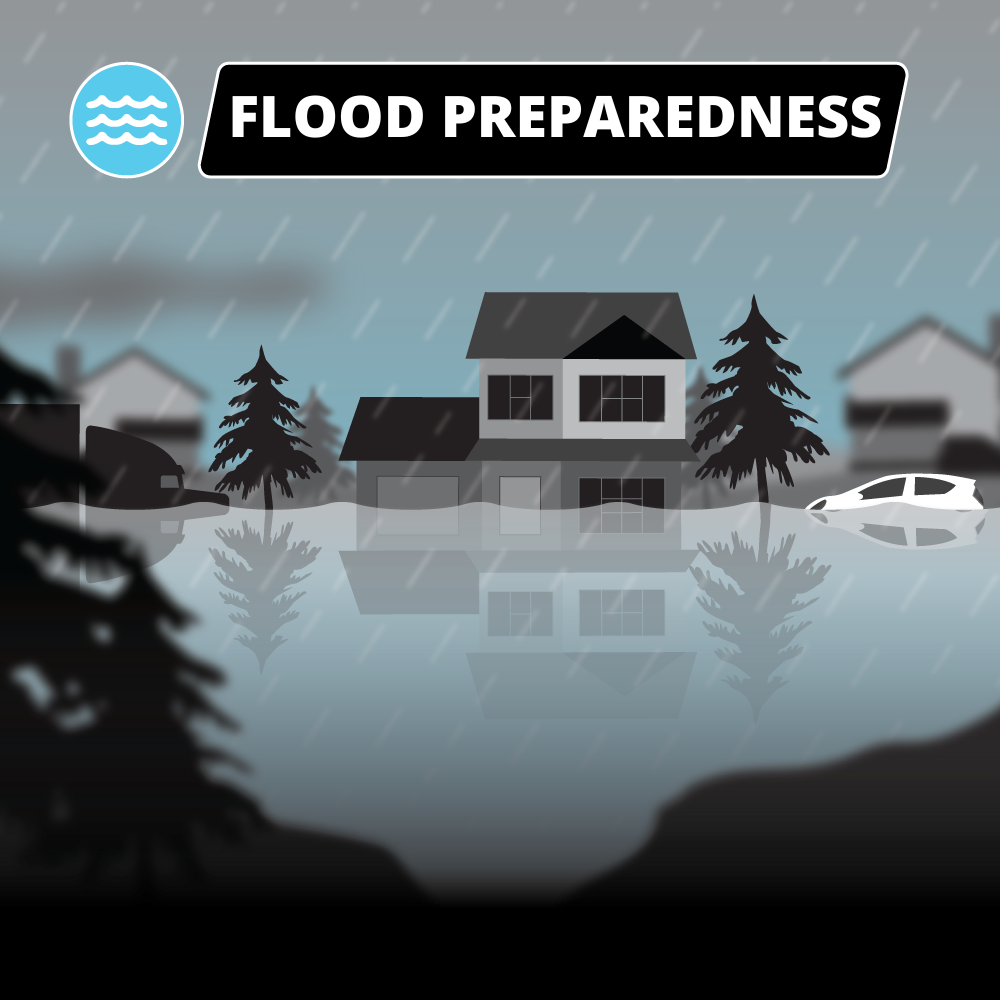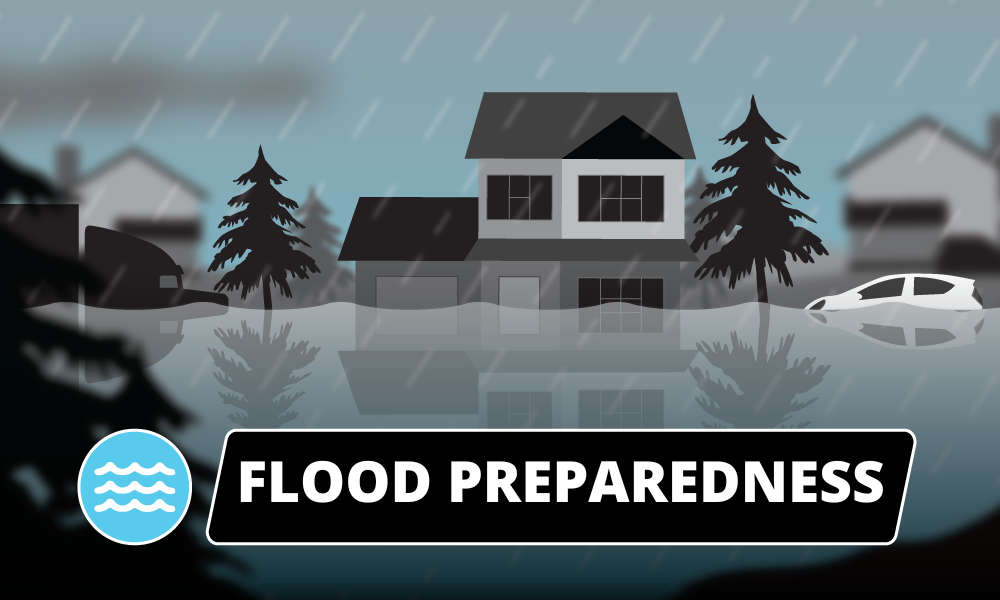Flood preparedness social media package

Preparing for flooding is an important step toward building resilient communities. To help we created an easy-to-use social media package with graphics and pre-written content.
Post this content directly to your own social media channels or follow @PreparedBC on Facebook, Instagram, and X (formerly Twitter) to share our posts!
Instructions for posting
- Copy-and-paste the content below in a new post
- Download, then attach the graphics below
- Option: add information, photos and hashtags specific to your community
- Double check the links and tagged accounts before you post
Graphics
Facebook or Instagram

X (formerly Twitter)

Content
X
Before a flood
The first step to getting prepared is learning what hazards could occur where you live. If you’re at risk of a #flood, make a plan and build a grab-and-go bag before waters start to rise. Learn more at: preparedbc.ca/floods
Floods are common in B.C. and can happen any time of year. The most severe floods usually occur in spring and early summer due to heavy rain and melting snow. Learn about preparing for a #flood at: preparedbc.ca/floods
Preparing for a potential #flood? Start by having a conversation at home. Talk about how you’ll communicate with each other and where you’ll go if you need to evacuate. Get started at: preparedbc.ca/emergencyplan
The @PreparedBC Flood Preparedness Guide is a must-read for anyone facing a potential #flood. Download it at: preparedbc.ca/floods
As #flood season gets closer, get prepared by making grab-and-go bags for everyone you live with. Be sure to pack everything you’ll need if you have to evacuate. Learn more about preparing for floods at preparedbc.ca/floods
If you're at risk of a #flood take time to prepare before waters rise. Start by creating an emergency plan and building grab-and-go bags for everyone in your home (including pets!). Learn more at: preparedbc.ca/floods
Don’t forget your pets when preparing for a potential #flood. Add their name, breed, vaccination history and a photo to your emergency plan. Learn more about pet preparedness at: preparedbc.ca/emergencyplan
Your pets will be counting on you during a #flood. Build them a grab-and-go bag so they’ll have everything they need if you have to evacuate. Learn more about pet preparedness at: preparedbc.ca/EmergencyPlan#pets
How will you get info about a #flood in your area? Start by contacting your local emergency management program & find out where they’ll share alerts and instructions.
Tip: edit this post and list what channels you will use to share information.
Heavy rain can cause sudden flooding. Stay tuned to local weather alerts if your area is at risk. Remember! Do not walk, swim or drive through flood waters. #Flood
#Flood tip: Put waterproof sealant around basement windows and below ground-level doors.
#Flood tip: Check that your roof and eaves are draining properly in heavy rains.
When choosing an emergency meeting place consider a virtual one too! Create a closed Facebook group for everyone in your home to check in during an emergency. Learn more at preparedbc.ca/emergencyplan
Are you prepared for a #flood? Check these tasks off your list:
✔️ Create your grab-and-go bags and emergency plan
✔️ Contact your insurance agent to verify your coverage for floods
✔️ Keep valuables, important documents and mementos in watertight containers
Get prepared for a #flood:
✔️ Review what your insurance covers
✔️ Keep documents in waterproof containers
✔️ Save digital copies of important paperwork
Prepare your home for a #flood:
✔️ Store valuables and important items or documents in water-tight containers or in high places, like on a tall shelf or upper floor
✔️ Clear gutters regularly
✔️ Keep nearby storm drains clear of debris
During a flood
If you are facing a #BCFlood, monitor local radio stations, television news and social media for the latest information from local officials.
#DYK? A mere 6 inches of rushing water can knock an adult off their feet. Two feet of water can carry away most vehicles – including trucks and SUVs. NEVER attempt to drive, swim or walk across flooded areas. Learn more at preparedbc.ca/floods #BCFlood
#BCFlood tip: Do NOT attempt to shut off electricity if water is present.
#BCFlood tip: Raise electrical appliances off the ground.
#BCFlood tip: Keep your phone battery as full as possible. Conserve battery life by dimming your screen and avoiding power-hungry apps and video. Find more tips at preparedbc.ca/floods
You can prevent or reduce #flood damage to your home by building a sandbag dike. Make sure you have enough sand, burlap or plastic bags, shovels and time to properly prepare. Learn more at: preparedbc.ca/floods
Under evacuation alert for #flood?
✔️ Have grab-and-go bags packed
✔️ Park vehicles away from waterways
✔️ Raise electrical appliances off the ground
✔️ Move valuable items to upper floors
✔️ Anchor fuel supplies
Learn more: preparedbc.ca/floods
Know the difference between an Evacuation Alert & Order before a #BCFlood.
Alert: It's time to get prepared to leave on short notice. Get your grab-and-go bags ready.
Order: You are at risk. Leave the area immediately.
Follow @EmergencyInfoBC and visit emergencyinfobc.ca for up to date information on #BCFlood.
After a flood
Cleaning up after a #BCFlood? Download the @PreparedBC Flood Preparedness Guide to help. PreparedBC.ca/floods
After a flood you may see mould. Mould grows in wet and damp conditions, but it's less likely to grow if you can dry out your items within 48 hrs. https://www.healthlinkbc.ca/healthlinkbc-files/clean-after-flood
Cleaning up after a flood can pose health risks. You may see or smell mould on clothing, drywall, furniture, cardboard boxes or books, but it may also be hidden under or behind items like carpet, cushions or walls. https://www.healthlinkbc.ca/healthlinkbc-files/clean-after-flood #BCFlood
Heading home after a flood? Remember it’s not safe to return until authorities say so and your home has been cleared of any structural, electrical or other hazards. #BCFlood
Before you start cleaning up, call your insurance company. Make a list of all damaged items. Take photos and keep related receipts. Learn more at preparedbc.ca/floods #BCFlood
Facebook or Instagram
Before a flood
The first step to getting prepared is learning what hazards could occur where you live. If you’re at risk of a flood, make a plan and build grab-and-go bags before waters start to rise. Learn more at: preparedbc.ca/floods
Floods are common in B.C. and can happen at any time of year. The most severe floods usually occur in spring and early summer due to heavy rain and melting snow. Learn about preparing for a flood at: preparedbc.ca/floods
The @PreparedBC Flood Preparedness Guide is a must-read for anyone facing a potential flood in B.C. Download it today so you'll know how to prepare for, respond to and recover from a flood. preparedbc.ca/floods
Preparing for a potential flood? Start by having a conversation at home. Be sure to discuss:
✔️ Where you’ll go if a flood gets too close to home
✔️ What you’ll bring with you
✔️ How you’ll find info about the situation as it develops
Write down your plan and keep it in a safe place. Learn more at: PreparedBC.ca/EmergencyKit
Flood season is approaching. Get prepared by creating grab-and-go bags for everyone you live with, including pets, in case you have to evacuate. Be sure to include:
✔️ Food and water
✔️ Phone charger and battery bank
✔️ Personal items like toiletries and an extra pair of glasses
✔️ Insurance papers and your emergency plan
✔️ Seasonal clothing
Find the full list and more tips to get prepared for a flood at PreparedBC.ca/EmergencyKit
Don’t forget your pets when preparing for a potential flood. Include them in your emergency plan by adding:
✔️ Their name and breed
✔️ Microchip number
✔️ Vaccination history
✔️ A photo for identification
Learn more about preparing your pet at PreparedBC.ca/EmergencyPlan#Pets
Your pets will be counting on you if you have to evacuate due to flooding. Build them a grab-and-go bag so they’ll have everything they need. Be sure to include:
✔️ Leash and pet carrier
✔️ Food and water with collapsible dishes
✔️ Treats and a favourite toy
✔️ Copy of vaccination records
✔️ Medications
✔️ Photos of them for identification
Learn more at: PreparedBC.ca/EmergencyPlan#Pets
Prepare your home for a potential flood and check these tasks off your list:
✔️ Create your grab-and-go bags and emergency plan
✔️ Contact your insurance agent to verify your coverage for floods
✔️ Keep valuables, important documents & mementos in watertight containers
Prepare your home for a flood, inside and out:
✔️ Review what your insurance covers
✔️ Keep documents in waterproof containers
✔️ Save digital copies of important paperwork
✔️ Store valuables and important items or documents in water-tight containers or in high places, like on a tall shelf or upper floor
✔️ Clear gutters regularly
✔️ Keep nearby storm drains clear of debris
During a flood
DYK? A mere 6 inches of rushing water can knock an adult off their feet. Two feet of water can carry away most vehicles – including trucks and SUVs. NEVER attempt to drive, swim or walk across flooded areas. Learn more at preparedbc.ca/floods
Building a sandbag dike? Follow these steps:
- Pick a location on high ground close to your home
- Dig a trench
- Fill bags about half way with sand (no need to tie or sew the bags)
- Start with a wide base: your wall should be three times as wide as it is high
- Alternate the direction of the bags as you build
Learn more at preparedbc.ca/floods
If you’re under and Evacuation Alert, you may have to leave quickly. Take these steps so you're ready to go:
✔️ Have grab-and-go bags packed
✔️ Park vehicles away from waterways
✔️ Raise electrical appliances off the ground
✔️ Move valuable items to upper floors
✔️ Anchor fuel supplies
✔️ Listen to local officials if you are asked to evacuate
Learn more about preparing to evacuate at: preparedbc.ca
Know the difference between an Evacuation Alert and Order if you’re at risk for a flood.
Evacuation Alert: Be ready to leave on short notice.
Evacuation Order: You are at risk. Leave the area immediately.
Learn about preparing for floods at: preparedbc.ca/floods
After a flood
Cleaning up after a flood? Download the @PreparedBC Flood Preparedness Guide to help you create a cleaning plan to return your home to normal. PreparedBC.ca/Floods
When you return home following a flood you may see mould. Mould grows in wet and damp conditions, but it's less likely to grow if you can dry out your items within 48 hours. For more tips on how to clean up after a flood visit https://www.healthlinkbc.ca/healthlinkbc-files/clean-after-flood
Heading home after a flood? Remember it’s not safe until authorities say so and your home has been cleared of any structural, electrical or other hazards. Visit PreparedBC.ca/Floods and https://www.healthlinkbc.ca/healthlinkbc-files/clean-after-flood for more tips on returning home.
Before you start cleaning up after a flood, call your insurance company. Make a list of all damaged items. Take photos and keep related receipts. Learn more at PreparedBC.ca/Floods
Tips for returning home after a flood:
✔️ Don't return home until officials say it's safe
✔️ Don't enter a building if you see buckled walls or floors
✔️ Don't attempt to turn on electricity until the wiring has been professionally inspected
✔️ If water needs to be drained, do so slowly to keep your home's structure safe
For more post-flood tips, visit preparedbc.ca/floods
